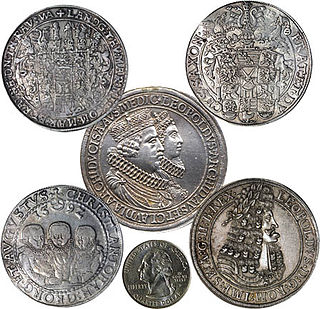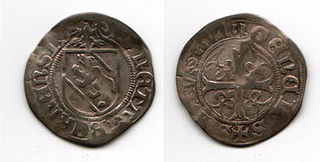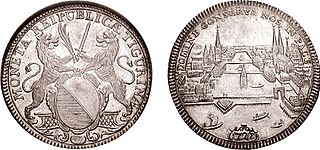
Guilder is the English translation of the Dutch and German gulden, originally shortened from Middle High German guldin pfenninc. This was the term that became current in the southern and western parts of the Holy Roman Empire for the Fiorino d'oro. Hence, the name has often been interchangeable with florin.

A thaler or taler is one of the large silver coins minted in the states and territories of the Holy Roman Empire and the Habsburg monarchy during the Early Modern period. A thaler size silver coin has a diameter of about 40 mm and a weight of about 25 to 30 grams. The word is shortened from Joachimsthaler, the original thaler coin minted in Joachimsthal, Bohemia, from 1520.

The batzen is an historical Swiss, south German and Austrian coin. It was first produced in Bern, Switzerland, from 1492 and continued in use there until the mid-19th century.

The Kreuzer, in English also spelled kreutzer, was a coin and unit of currency in the southern German states prior to the introduction of the German gold mark in 1871–1873, and in Austria and Switzerland. After 1760 it was made of copper. In south Germany the kreuzer was typically worth 4 pfennigs and there were 60 kreuzers to a gulden. Kreuzer was abbreviated as Kr, kr, K or Xr.

The Vereinsthaler was a standard silver coin used in most German states and the Austrian Empire in the years before German unification.

The Conventionstaler or Konventionstaler, was a standard silver coin in the Austrian Empire and the southern German states of the Holy Roman Empire from the mid-18th to early 19th-centuries. Its most famous example is the Maria Theresa thaler which is still minted today. The Conventionsgulden was equivalent to a 1⁄2Conventionsthaler.

The Reichsthaler, or more specifically the Reichsthaler specie, was a standard thaler silver coin introduced by the Holy Roman Empire in 1566 for use in all German states, minted in various versions for the next 300 years, and containing 25–26 grams fine silver.

The Austro-Hungarian gulden was the currency of the lands of the House of Habsburg between 1754 and 1892, when it was replaced by the Austro-Hungarian krone as part of the introduction of the gold standard. In Austria, the gulden was initially divided into 60 kreuzers. The currency was decimalized in 1857, using the same names for the unit and subunit.
The South German Gulden was the currency of the states of Southern Germany between 1754 and 1873. These states included Bavaria, Baden, Württemberg, Frankfurt and Hohenzollern. It was divided into 60 kreuzer, with each kreuzer worth 4 pfennig or 8 heller.

Baden used the South German gulden as its currency from 1754 until 1873. Until 1821, the Gulden was a unit of account, worth 5⁄12 of a Conventionsthaler, used to denominate banknotes but not issued as a coin. It was subdivided into 50 Conventionskreuzer or 60 Kreuzer landmünze.
The Thaler was a coin issued by Baden of varying equivalents to its currency, the South German gulden, each of 60 kreuzer. Beginning in 1690, the Reichsthaler specie coin of 25.984 g fine silver was issued for 2 gulden. After 1754, the Conventionsthaler of 23.3856 g fine silver was issued for 2.4 gulden. Starting in the 19th, century the Kronenthaler of 25.71 g fine silver was issued for 2.7 gulden ; the French silver écu also started being accepted for 2.8 gulden. After 1837, the doppelthaler, which was worth two Prussian thalers, was issued for 31⁄2 gulden. From 1857 to 1871, the Vereinsthaler was issued for 13⁄4 gulden.
Württemberg used the South German gulden as its currency until 1873. Until 1824, the Gulden was a unit of account and was used to denominate banknotes but was not issued as a coin. It was worth 5⁄12 of a Conventionsthaler and was subdivided into 50 Conventionskreuzer or 60 Kreuzer Landmünze.
The Fribourg Gulden was a currency denomination worth 14 Batzen of the Swiss canton of Fribourg until 1798.
The Frank was the currency of the Swiss canton of Fribourg between 1798 and 1850. It was subdivided into 10 Batzen, each of 4 Kreuzer or 10 Rappen. It was worth 1⁄4th the French silver écu or 6.67 g fine silver.
The gulden a currency denomination of Neuchâtel equal to 21 batz until 1850. Neuchâtel's basic currency unit was the livre, divided into 10 batz or 40 kreuzer. The French silver écu was worth 42 batz or 2 gulden. It was replaced by the Swiss franc.
The Thaler was a currency denomination worth 2 Gulden used by St. Gallen until 1798.
The Frank was the currency of the Swiss canton of Thurgau between 1798 and 1803. It was subdivided into 10 Batzen, each of 4 Kreuzer. It was worth 1⁄4th the French silver écu or 6.67 g fine silver.

The cantons of the Old Swiss Confederacy used a currency system consisting of based on the old unit of the Schilling, with the Schilling divided into 4 Rappen or 12 Haller. The Taler was a large silver coin equivalent to 72 Schilling or 2 Gulden that came into use in the 16th century. The Batzen was an intermediate coin equivalent to 2 Schilling or 1⁄18Gulden.

The Munich Coinage Treaty of 1837 was a treaty between six southern German states who agreed to form the South German Coinage Union and to unify their currencies together with some of the central German states. The Munich Coinage Treaty was updated by the South German Coinage Convention of 1845. The agreement is less commonly known as the Munich Coin Treaty.
The North German thaler was a currency used by several states of Northern Germany from 1690 to 1873, first under the Holy Roman Empire, then by the German Confederation. Originally equal to the Reichsthaler specie or silver coin from 1566 until the Kipper und Wipper crisis of 1618, a thaler currency unit worth less than the Reichsthaler specie was first defined in 1667 and became widely used after adoption of the Leipzig currency standard of 1690.











